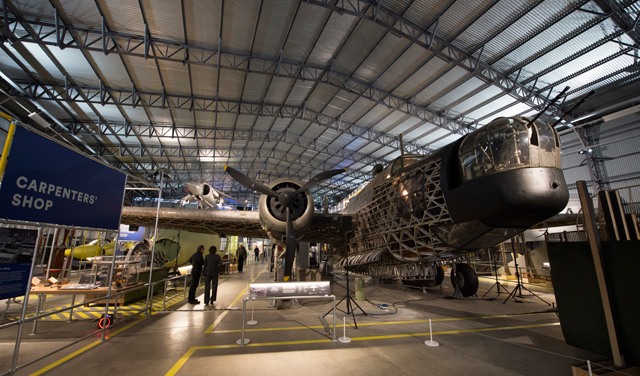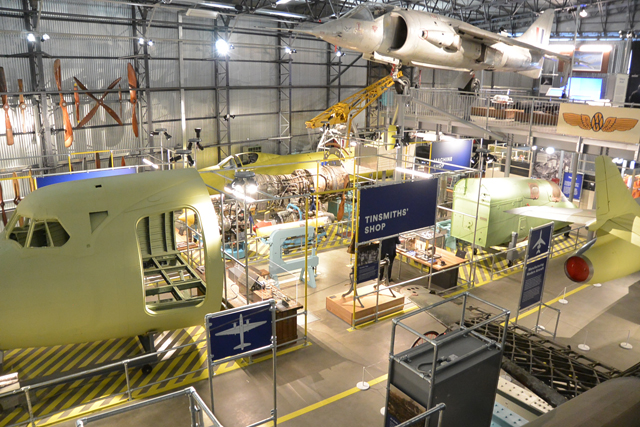Many countries have renowned air museums. Few if any – until now – have set out to explain the history of aircraft design and manufacturing. The new Brooklands Aircraft Factory – part of a £10.7 million ($14.2 million) facelift of the aviation and motor racing heritage centre in Weybridge, just outside London – celebrates the legacy of three famous UK aircraft companies: Weybridge-based Vickers, as well as Sopwith and Hawker in nearby Kingston.
Importantly, however, it also details how innovations from the Vickers Vimy biplane bomber to the Airbus A320 wing were conceived and constructed, with interactive displays and examples of actual structures. Those behind the project hope it will inspire a new generation – starved of metalwork and woodwork lessons in schools – not only to continue studying science, technology, engineering and maths (STEM), but comprehend the craft skills behind aircraft design.
The story of the Aircraft Factory itself is as fascinating as the exhibits inside. A hangar was erected in 1940 to assemble Wellingtons when the pre-war Brooklands racetrack was shut and fully requisitioned for aircraft production, and had been used since the museum opened in the early 1990s for storage and restoration work. The project saw the original building dismantled and rebuilt an aircraft’s length away on what had been effectively the Vickers landfill site.

The only surviving Brooklands-built Vickers Wellington takes pride of place
Brooklands Museum
The wartime hangar had been built on the finishing straight and its relocation means that the famous 300m stretch of the racetrack – its surface now restored – is visible for the first time in almost 80 years. The Bellman hangar itself has been meticulously rebuilt, using 90% of the original materials. Although the cladding has been replaced and modern necessities such as fire doors added, the building has even been painted using the original wartime camouflage.
Once inside, the idea was to create as closely as possible the look and feel of the original factory, with “assembly lines” running the length of the 54m-long building. Pride of place goes to the only surviving Brooklands-built Wellington – N2980 was pulled from Loch Ness in 1985, 45 years after ditching there during a training flight. Appearing suspended from the roof – although actually supported on pylons – is a restored Hawker P.1127 “jump jet” prototype.

Restored P.1127 "jump jet" prototype hangs above a replica of the original assembly line
Aviation images/REX/Shutterstock
Entering the “factory”, there is a chance to clock-in on one of the original machines that would have been used by Vickers employees, and see the overalls they would have worn. Display boards explain what life would have been like for a member of staff during the factory’s heyday. Special emphasis is given to the role women played in the life of the production plant, especially in wartime.
Other notable exhibits range from a Bleriot XI, built under licence in nearby Addlestone, to the nose section of the last Valiant to fly. There is a rudder from Concorde and flightdeck mock-up of the Vanguard turboprop airliner. On a new mezzanine sits a recreation of Hawker Hurricane designer Sydney Camm’s office, with the original desk, chair and drawing board. A new hangar next door, connected by a walkway, houses a Hurricane and Sopwith Camel, among others.
Some 19,000 aircraft were produced at Brooklands between 1908, when it became one of the country’s first airfields as well as its only purpose-built racing circuit, and 1989 when the by now British Aerospace-owned factory finally shut its doors. Luckily, diligent employees and former employees sought permission to begin archiving precious artefacts, including jigs, machinery and even office furniture, which were eventually stored in the museum.
The new building – largely funded by a grant from the UK’s national lottery, but also by private donations – gives the museum a chance to publically display many of these items for the first time (others had been exhibited outside or in smaller buildings). Explains Brooklands chief executive Allan Winn: “There was nothing that told the story of civil aircraft in this country. We are now able to show how aircraft were designed and built over an 80-year period.”
Winn, a former editor of Flight International who retires early next year after 15 years running Brooklands, adds: “The 10 years of effort by our staff, volunteers and contractors, and the generosity and vision of our funders, have produced an exhibition which will inspire future generations to embrace the STEM subjects and thus help sustain the country’s vital technological industries. It’s the biggest and boldest project the museum has ever undertaken.”
Source: Flight International


























